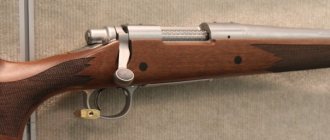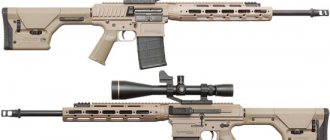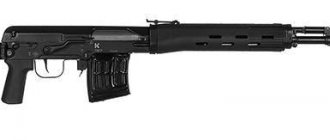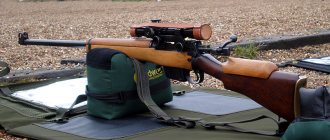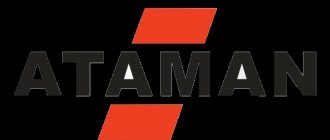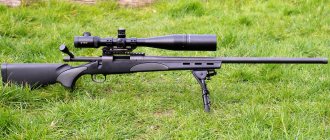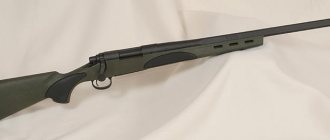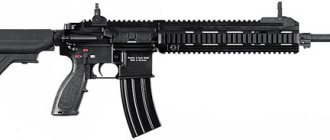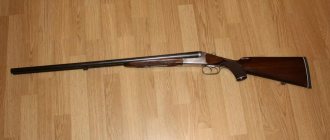After the publication of the article “Remington 870 - the last real thing,” there is simply no end to people wanting to know more about this gun. Potential owners are interested in operating features, range and availability of accessories. But most often they ask us to talk about the existing versions of this legendary shotgun.
I regularly have to answer letters and calls, and sometimes I happen to share such a joyful moment with new owners as buying their first weapon. I would like to note that interest in the Remington 870 is constantly growing, and this is good news. This article will help you figure out which Remington 870 is right for you. We'll take a closer look at each version of this world's most popular pump-action shotgun. You were not mistaken in choosing the Remington 870, and the choice of modification is all about the details. Before writing this article, I specially went to the shooting range to once again hold and shoot all modifications of the Remington 870 available on the Ukrainian market - Express, Deer, Tactical, Marine, Police, Combo. All of these guns have the same design, which has remained virtually unchanged since 1950, when the Remington 870 was born, but they differ in configuration, barrel configuration, and some parts and accessories. What all guns have in common is predictability, reliability, precise operation, convenient controls and sights. The basic design of the Remington 870 provides smooth handguard movement, clean round feeding, and reliable case ejection. And it doesn’t matter whether it was a standard cartridge with a 70 mm sleeve or a 76 mm magnum.
One platform
It should be noted right away that all parts and barrels of different versions of the Remington 870 are interchangeable: you can change the stock, forend, barrel, and also install many accessories - the possibilities for tuning and fine-tuning this gun are simply endless. The only exception is the Tactical version with a one-piece extended magazine - to install a barrel from the regular versions on this gun, you need a special adapter. This is the price for a more reliable store design. Also different from the tactical and police versions of the Remington 870 is the presence of a stamping at the end of the magazine: these two protrusions are needed to hold the magazine spring retainer. To install a magazine extension on regular versions, the stamping must be removed - this is done in the workshop in 10 minutes and subsequently does not affect the characteristics of the gun in any way.
Remington 870 with Magpul forend and stock and Mesa Tactical side bandoleer
Some configurations come with an original Remington magazine extension. This extension cord has several features. Firstly, there is a groove on it into which the tie screw goes. Thus, the coupler is fixed and does not move due to strong recoil - which means that the barrel and extension are not scratched. The second function of the groove is to block excessive movement of the feeder along the extension pipe in order to protect the magazine spring from too much compression and, accordingly, wear. You may also notice a protrusion on the extension - it is needed to install a standard bayonet. This is a legacy from the military past of the Remington 870. If you wish, by purchasing an additional adapter, you can install an American army bayonet-knife on your gun - in case of, say, a zombie apocalypse. All standard Remington 870s are finished in a matte, non-reflective bluing finish. It does its job of protecting the metal, but it also requires maintenance. Before going to the shooting range or hunting, it is advisable to wipe all metal parts with oil so that a thin protective film remains, or treat them with Shooter's Choice Rust Prevent. This way you will protect your gun from rust - even if you get caught in fog, rain or snow, or if condensation appears on the metal parts.
Magazine extension lock available on tactical and police versions
Remington-700 LTR - elite copy
The Remington-700 LTR modification is very rare. This is a real tactical sniper rifle chambered in .308 caliber. This modification costs much more than the popular Remington-700 models, and therefore differs in build quality. All metal parts of the weapon are coated with black Teflon, which is why in the USA this rifle is called the “Black Rifle”.
Fiberglass was used to create the stock. This made it possible to reduce the total weight of the weapon. The rifle body can be designed according to the taste of the future owner. There is a notch on the butt plate of the rifle that prevents the butt from sliding off the shooter's shoulder.
Basic versions
We will begin to consider guns in ascending order of price. Three basic, low-cost versions are available: - Remington 870 Express with a long 71 cm (28") barrel and wooden forend and butt. I would like to note that the material used for the butt and fore-end is not laminated wood, but high-quality beech. — Remington 870 Express with a long 71 cm barrel and a plastic butt and long forend. — Remington 870 Express with a short 47 cm (18.5”) barrel and a plastic butt and short forend.
Diopter rear sight on Remington 870 Express Tactical
These guns (both long and short barrels) use a classic ball front sight as sighting devices. The standard magazine capacity is four rounds; it can be increased using an extension cord. The two-round magazine extension will be just flush with the short barrel. Long barrels have a ventilated rib and internal threads for installing interchangeable choke constrictions (the basic package includes one - “polochok”; the rest are available optionally). The short barrel is made with a constant “cylinder” type narrowing. As you can see, even in the basic configuration there is plenty to choose from: two versions with a long barrel are suitable for hunters or practical shooters (a longer barrel provides an increased range of effective shooting with shot, and the ability to change the choke allows you to adjust the characteristics of the shot depending on the situation, which for hunting it is simply irreplaceable). The short-barrel version is an excellent option for self-defense, since a short barrel without narrowing is best suited for shooting large shot or buckshot at close ranges and at the same time provides a wide dispersion of the striking elements (that is, the chances of hitting the target increase). At the same time, the length of the short barrel approaches the minimum allowed by Ukrainian legislation.
Lock picker for Remington 870 Express Tactical
Of course, it will be useful to install additional accessories and tuning elements, depending on the purposes for which you are purchasing the gun.
Specifications of Remington-700-223 Rem
Since Remington-700-223 and Remington-700-308 differ only in caliber, their performance characteristics are practically no different from each other:
- All Remington 700 carbines are bolt-action (or bolt-action) repeating rifles;
- The barrel length of the Remington-700-223 Rem is 559 mm;
- The magazine holds 5 rounds, with one more in the chamber. The .308 has a 4-round magazine;
- The stock is made of plastic and has elastron inserts. Her uniform is half-pistol;
- The total length of the carabiner is 1050 mm;
- Weapon weight – 3.2 kg. The Remington .308 weighs 3.6 kg.
Although carbines with a plastic stock and buttstock are better suited to humid climates, many users prefer a traditional wooden stock. The wood stock has a Remington-700 VLS.
Remington 870 Express Deer
The next version is the Remington 870 Express Deer. The English word deer means "deer". I would like to note that in North America, not all deer living there are called this way, but only white-tailed and black-tailed deer (also known as “mule deer”), which in terms of weight and size characteristics are significantly inferior to our red deer. As for the elk deer, which is a North American subspecies of red deer, in the USA they are usually called elk - that is, literally “elk” (or American elk). But let's get back to weapons. As the name suggests, this gun is “sharpened” for hunting ungulates, that is, for shooting with a bullet and/or buckshot (remember that in Ukraine shooting at ungulates with a segmental charge is prohibited). It is logical that the Deer version is equipped with a short 51 cm (20”) barrel with rifle sights consisting of a front sight and an adjustable rear sight, and a fixed “pressure cylinder” constriction. The front and rear sights provide very comfortable aiming, and if desired, they can be replaced with light-collecting or even tritium sights. Installing them in their standard places will not cause problems even for a person who is far from weapons.
The wooden stock and forend give this gun a classic look. There is no magazine extension; the magazine capacity is standard - four rounds in the barrel tube and one in the chamber. This gun is suitable for hunters: as already noted, it is very convenient to shoot bullets and buckshot from it. In addition (which many people forget), a short barrel with virtually no constriction is very good for shooting with small shot at feathered game that flies up almost from under your feet - that is, for hunting quail and partridge. Also, the Express Deer version will be a good basis for a self-defense shotgun: the short barrel ensures compactness and turning ability, and if desired, you can add a magazine extension and other accessories. To ensure that the tip of a tubular magazine is flush with the muzzle of a barrel of this length, you will need a three-round extension. This will make the gun more suitable for tactical and self-defense use.
Remington-700 SPS and its features
The Remington-700 SPS is the most popular civilian model of the Remington-700. This is a simple and inexpensive rifle with a good service life. Used for hunting small or medium game. If this is a modification of the Remington-700 SPS varmint 308 win, then with this rifle you can hunt larger prey. This carbine can be used in a wide temperature range from -50 to +50 degrees.
Since the Remington-700 SPS stock can be customized to suit any hunter, this makes the rifle even more popular. Since most Remington-700 SPS models are chambered in .223 caliber, this rifle is legal in a number of countries.
Remington 870 Express 7-Round
Next we'll look at the Remington 870 Express 7-Round version. This gun features a short 47 cm barrel without a taper (cylinder bore), a plastic stock and a short fore-end, as well as an enlarged magazine. The magazine tube is long and solid, without joints or extensions, which makes it more reliable than composite structures. Thus, the supply of cartridges becomes smoother, and even the slightest chance of misalignment of the spring or feeder at the junction of the tubular magazine and the extension disappears. The short barrel makes the gun more maneuverable, making it more convenient to use in rooms, narrow corridors, cars and other confined spaces. Plastic stock and forend are lighter than wood, they are more wear-resistant, and are difficult to scratch or damage. The ribbed texture on the fore-end makes it more grippy and ensures precise reloading.
Premium Remington SuperCell recoil pad
Among the sights, the Remington 870 Express 7-Round has only a front sight. It is often replaced with tritium, which glows in the dark, making the gun even more suitable for self-defense, especially in the dark. For these purposes, the Remington 870 Express 7-Round configuration itself is ideal: right out of the box it is ready to carry home defense.
A successful package is not when there is nothing to add, but when there is nothing to take away. And the Remington 870 Express 7-Round is just such a simple and extremely effective shotgun.
Remington 870 Combo
Next comes probably the most popular version of the Remington 870 shotgun - the Combo. It is equipped with two barrels - long and short (they are also sometimes called shot and bullet). This kit is suitable for both hunting and home protection. The Remington 870 Combo impresses with its versatility; it can be used for almost any type of hunting, for self-defense, and even for practical shooting. Therefore, if you are a beginner and have not yet decided exactly what you want to do in the future, then this kit is for you: for a small additional payment, for one permit, you get a gun with two barrels.
Remington 870 Milled Extractor
There are two versions of the Combo kit - in plastic and wood (the version with plastic forend and buttstock is cheaper). They also differ in their trunks. The option with a plastic stock and fore-end, or Synthetic Combo, is equipped with a short 47-cm (18.5”) barrel with a constant “cylinder” constriction and a long 66-cm (26”) barrel with threads for interchangeable choke constrictions (DS). Basically, a “payday” is installed there, other DS are available optionally). Both barrels of the “plastic” version have ball front sights; the long barrel is also equipped with a ventilated rib.
The “wooden” version of the Combo comes with 51 cm (20”) and 71 cm (28”) barrels. The short, drilled “cylinder with pressure” has rifle sights - a front sight and an adjustable rear sight. The long one is equipped with a ventilated rib and a ball front sight; it also has a thread for interchangeable barrels (the basic package, like the long Synthetic Combo barrel, includes one of them - “polochok”).
Remington 870 Police front sight. Remington 870 Police rear sight
The Combo version in both versions is simply adored by shooters and is the first to be sold out. Therefore, if you have the opportunity to take a set with two barrels, take it without hesitation.
Remington 870 Express Tactical
Let's move on to the aggressive tactical version - Remington 870 Express Tactical. The features of this gun immediately catch the eye: a Picatinny rail mounted on the receiver, combined with a diopter-adjustable rear sight; and a high front sight (the rear sight and front sight for this gun were developed by XS Sights from
Fort Worth, Texas); and a special “breacher” choke—a “guest choke,” as our second editor calls this thing. Simply put, this is an attachment for knocking out door locks and hinges. It has teeth that can be used to rest against the door frame so that the barrel does not slip, as well as many holes for the removal of powder gases so that it does not burst when fired at point-blank range. Of course, the likelihood that a civilian user will need to kick out a door lock is extremely small - and it is unlikely that he will want to use this feature of his gun even if he forgot the keys somewhere. However, instead of this nozzle, you can install any other choke, which is an extremely useful option and expands the possibilities of using the gun. This version also has a magazine extension installed, which increases the total magazine capacity to six rounds. A special feature of the design is the magazine extension retainer - this is a metal ball pressed into the barrel guide ring. This is installed only on some models for greater reliability.
The tactical version is perfect for home defense, it has everything you need, you don’t have to buy anything in addition, and the ability to replace the choke will allow you to use this gun for hunting - although, of course, the barrel is only 47 cm long when shooting with shotguns is only applicable for limited purposes range of distances.
Comparison of Combo version barrels: both barrels of a gun in plastic are slightly shorter
The diopter rear sight (its version with a diopter of a sufficiently large diameter is usually called a ghost ring) is not entirely familiar at first, but is intuitive. Once you get the hang of aiming techniques, shooting bullets will be a pleasure. Diopter sights of the ghost ring type are installed on many types of weapons. But for tactical weapons this is generally the main option. It is believed (and this is true) that they are simpler and more convenient than the open rear sight with a semicircular recess familiar to post-Soviet shooters - in the case of a ghost ring, aiming is faster, and the ring of increased diameter overlaps the target less.
With a gun like the Remington 870 Express Tactical, you'll be the center of attention on the range.
Operating principle of Remington-700 carbines
Shooting from Remington-700 carbines takes place according to the following algorithm:
- First you need to load the cartridges into the magazine hopper. Loading can only be done through the cartridge ejector window. To carry out this procedure, you need to move the safety catch forward, then lift the bolt handle and move it (the bolt) as far back as possible;
- When the magazine is filled to capacity with cartridges, you can add an additional cartridge to the chamber of the carbine. To do this, the cartridge is simply placed on top of the stacked cartridges, after which the bolt must be moved forward and its handle lowered down. If safety requirements dictate the absence of a cartridge in the chamber, then the last cartridge must simply be “sunk” in the hopper by passing the bolt cylinder over it;
- After this procedure, the carbine is ready to fire. If there is no need to shoot at the moment, the weapon is put on safety.
If you need to completely discharge the carbine, you need to use a special hopper lever. All cartridges are unloaded, the bolt is jerked and a control release is performed. In this case, the barrel of the weapon must not be pointed at people or animals.
Remington 870 Police
As you know, the Remington 870 is the most popular pump-action shotgun in the world, and the Police version is simply the essence of reliability and the standard of tactical shotguns. This gun has served in American police patrol cars for many decades and is a powerful argument when the situation goes too far. The Remington 870 Police continues to be regularly purchased by law enforcement agencies both in the United States and abroad. And if the previous versions of the 870 we reviewed did not differ too significantly, then the police modification is worth dwelling on in more detail.
Firstly, a “police” gun is tested much more thoroughly - it goes through 23 levels of control, and all its elements are checked manually to exclude the presence of even the slightest flaws. The Remington 870 Police is assembled in a separate, dedicated workshop.
Remington 870 Express 7-Round One-Piece Extended Magazine
A number of parts differ from the components of civilian versions - this is done in order to ensure even more reliable operation. For example, the Remington 870 Police magazine spring is extended, which may make loading a little more difficult, but will ensure reliable feeding. Police rifles also have a ball that retains the extension/magazine cap, which is already familiar to us from the Tactical version. The trigger pull has been increased to reduce the risk of accidental discharge. The forend is shortened, which provides greater convenience when transporting the gun in a patrol car, as well as access to the loading window even with the forend fully moved back and the ability to install side bandoliers on the receiver. A magazine extension is installed, which allows you to load more cartridges. Instead of traditional coating of metal parts, more durable and wear-resistant phosphating is used. The trigger body and trigger guard of the Remington 870 Police are made of metal, and not of polymer, as in the previous versions reviewed. The extractor is made from a milled forging, which provides it with greater strength and durability.
Because of these significant design changes and the benefits they provide, the police version of the Remington 870 costs significantly more than regular Remingtons. The Remington 870 Police is available in several versions, differing in barrel length (18" or 20") and stock configuration. There are currently two versions of the Remington 870 Police on sale, each with a 46cm (18”) barrel and plastic forends and buttstocks, which is why we'll be describing them here.
The Remington 870 Police shotgun with a classic plastic stock differs from the basic versions in the premium SuperCell recoil pad, which significantly better absorbs recoil and reduces barrel bounce, allowing you to shoot faster. The classic stock configuration transfers all the recoil to the shooter's shoulder, so you can shoot a lot with it without fatigue or bruises - unless, of course, you use reinforced ammunition. This version of the police gun has the already familiar rifle sights with an adjustable rear sight. Also, with the help of a corresponding extension, the magazine capacity has been increased by two rounds. The coating on the extension is phosphating, exactly matching the coating on the gun itself.
The second option comes without a magazine extension (if you want to increase the magazine capacity, you will have to buy an extension), but it is equipped with a telescopic stock with a pistol grip from the BLACKHAWK company! A pistol grip stock has advantages when shooting from awkward positions, and also does not require retraining or adaptation if you are simultaneously training with a tactical carbine. In addition, the telescopic butt can be adjusted to suit the shooter with any anthropometric data and to suit any type of clothing or equipment used (for example, when wearing body armor, butts of reduced length are more convenient, which is easily achieved in the case of a telescopic butt). Another useful option is the many variations of sling attachments to this stock. However, when shooting, due to the configuration, part of the recoil is transferred to the shooting hand, which may require getting used to.
Also, instead of the standard ones, this version of the Remington 870 Police has an adjustable diopter sight from Scattergun Technologies installed on the receiver. Milled from a block of steel, this rear sight is as reliable as the Remington 870 Police itself. You get used to it very easily and quickly - and aiming becomes very fast, and shooting becomes very accurate.
Remington: the simplest rifle in the world!
They say that 80% of men are killers at heart. And this is quite believable if we remember our thousand-year biological history: men hunted game, and women collected grains. Therefore, it is not surprising that we enjoy holding a weapon in our hands, having it at home, reading articles about it in magazines, and even shooting it ourselves - what have you. And every man, in general, has his own favorite model - for some it is an army machine gun (“the love of youth”), for others an expensive hard drive bought in the states for bucks (“just like in cowboy films”), and someone has something else. I personally really like... Remington bolt action rifles (or tap action, that's what they say). However, for some reason, offensively little has been written about them, although in the history of armed struggle of the late 19th and early 20th centuries. she had a very important role to play!
Remington .46 caliber 1865 carbine.
Well, the story about this weapon will need to begin with the reflection that one of the quirks of the history of technology is that a good idea often occurs in the minds of different people, and at approximately the same time. But even more often it happens that a completely different person uses a good idea. And this is exactly the story with the Remington rifle from this number. And, by the way, it is very instructive in all respects.
Eliphalet Remington.
Eliphalet Remington himself was born on October 28, 1793, and died on August 12, 1861. Like many other Americans, he was born into a family of emigrants from England who went to seek their fortune overseas. Having become a blacksmith, at the age of 23 he made a good rifle, for which he forged the barrel, and bought the mechanism from a visiting merchant. And since he liked the rifle, and he worked out the technology, the only thing was to open his own company to manufacture it, which he did. .
Remington "New Model" capsule revolver mod. 1858.
The company was officially registered in the city of Illion, New York in 1825. Father and son worked together for 19 years, after which they hired Eliphalet Sr.’s nephew, Philo Remington, into their business. And then two more sons of the company’s founder, Samuel and Eliphalet the Third, joined the family business.
1875 .44 caliber cartridge revolver, decorated with engraving.
After this, the company was renamed E. Remington and Sons." The company operated under this name until 1888, when the reins of management passed into the hands of the grandchildren of the company founder, Graham and Hartley Remington. The brothers decided that “Remington Arms Company” sounded more respectable than the previous name invented by their grandfather, and without hesitation, they changed it for the third time. It still exists under this name today, although it no longer produces only weapons.
Remington revolver rifle.
The company first became famous thanks to a revolver created in 1863, which competed with Colt himself (who, by the way, had already died at that time!) and was adopted by the American army. The success of the revolver, which had a solid closed frame, unlike Colt revolvers, led its owners to the idea of producing revolver carbines of the same system. Well, almost simultaneously with this revolver and its revolving rifles, the company released its world masterpiece - a cavalry carbine with the so-called crane bolt or “rolling block” bolt, as the Americans themselves call it.
Moreover, it was not Remington or his sons who invented it, but a certain Leonard Geiger. For a long time they thought that he was an employee of the Remington company. However, thanks to new research done by Ed Hull, it became known that Geiger not only did not work for the Remington family, he may never have even met them.
The bolt and trigger of the carbine mod. 1865.
But Joseph Ryder was indeed a collaborator and he developed his shutter almost simultaneously with Geiger. In any case, the similarity between the ideas of Geiger and Ryder is obvious. Ryder received his patent on November 15, 1864. Geiger - April 17, 1866. And here, instead of suing, she bought the patent rights from Geiger. The two Geiger brothers got rich from this, but now everyone began to call the shutter of Joseph’s design “Remington”!
The shutter is open.
However, the company managed to produce rifles based on Ryder’s patent, which received the designation “Old Model Carbine.” In March 1864, the federal government ordered 1,000 of these .46 caliber (11.6 mm) rimfire carbines. In December the contract was revised and the order increased to 5,000 copies. The first 1,250 were produced in February 1865, more than 1,500 were produced in March, and final delivery was made on April 30, 1865. At the same time, Remington signed a second contract (in October 1864) for 15,000 carbines, called the “second model.” They were chambered for the more powerful .50 caliber (12.7 mm) Spencer cartridge, also rimfire, which was used in the Model 1865 seven-shot carbine. The first 1,000 were delivered to the army in September 1865, five months after the cessation of hostilities. The remaining 14,000 carbines were completed by March 1866 and the Army declared them surplus. Therefore, in November 1870, the company bought the entire supply from her and sold the rifles to France, where they were used during the Franco-Prussian War!
Carbines also turned out to be successful weapons. At least for riders. It was the Remington Sporting carbine that General Custer was armed with in the fatal battle with the Indians at Little Big Horn in 1876. A general (even if he fought there with the rank of colonel) could probably afford any weapon. But he chose unpatriotic large-caliber Bulldog revolvers and... a single-shot Remington carbine!
Remington 1871 rifle chambered in Spanish .43 caliber, made in Spain. Produced by the Spanish National Arsenal in Oviedo.
Well, the “faucet valves” themselves were also produced not, but from Middleton, Connecticut. That is, everything was the same as before, when Eliphalet Remington himself forged the barrels for his rifles!
Well, now let's look at the technique itself. After all, before us is, undoubtedly, the most ingenious bolt for a rifle of all time, and there is simply no equal to it in its completeness, simplicity and reliability.
Leonard Geiger patent.
Let's turn to Geiger's patent, because in the drawing from it everything is very clearly visible and clear. What immediately captivated Remington's gunsmith technologists with this bolt was its simplicity and high technology. After all, the entire bolt consisted of only three main parts, two axles and four springs, not counting the screws. The bolt itself had the shape of an inverted letter P, and the trigger, chambered for a circular ignition cartridge, was typical for its time and consisted of a spoke and a striker. Both of these parts were large and therefore durable, they rotated on massive axes, so there was simply nothing to break in the shutter! In this case, the released trigger entered the middle groove of the bolt and, in fact, in a closed state formed one whole with it.
Fastening of the shutter axes using one screwed plate. Once removed, they could be easily knocked out and the bolt and trigger removed.
This shutter worked like this. In order to fire a shot, you had to pull the trigger back with your thumb. At the same time, he was held in this position by the trigger. Then a U-shaped shutter was retracted back, which had grooves for fingers on its protrusions on the left and right. Now it was possible to insert a cartridge into the barrel and press it with a bolt, spring-loaded from below with a special spring. After that, all that was left was to aim and pull the trigger. The latter entered the bolt, firmly propped it up so that no recoil force could throw them back together, and at the same time hit the rim of the cartridge with its striker.
A shot followed, after which everything had to be done in reverse order. At the same time, the extractor pushed the cartridge case out of the barrel, and the rifle was ready to be reloaded.
Sports carbine .32 caliber.
From 1867 to 1896 it produced a huge number of rifles and carbines chambered for black powder cartridges. For example, in 1869, 125,000 rifles of this system were supplied to Turkey alone.
One of the many Remington rifle models.
And then the Berdanov center-fire cartridge appeared, and the company had to remake its bolt to fit the new product. It all came down to the following changes: thus, the bolt took the shape of a trigger, inside of which there was a channel for the firing pin. A curved plate (“spoke”) was installed on its right side to move it back. And these are all the changes! Now the trigger hit the firing pin and, just as before, firmly locked it in the “dead center.”
Advertising leaflet.
Moreover, despite the fact that in 1896 many countries had already switched to multi-shot rifles, Remington still produced “single-shot” rifles, but chambered for smokeless powder cartridges and sold them all over the world. The rifles were produced in the following calibers: 6 mm (.236 Remington caliber), 7 mm for Mauser cartridges for Spain and Brazil, 7.62 mm (.30 US caliber), and 7.65 mm for Belgium and Argentina , Chile and Colombia. What attracted you? Cheap - since the cost of the rifle was only 15 dollars with a bayonet. And high fighting qualities. For example, the barrel length was emphasized - 30 inches, despite the fact that it itself was shorter than many others, and the weight was about 4 kg with a bayonet. The rifle's rate of fire was higher than that of many magazine models and reached 15 rounds per minute.
The effective firing range was 900 meters, although some rifles had sights at 1280 meters. It was also easy and convenient to disassemble and clean. Both axes of the trigger and bolt were kept from falling out by a special plate on the left side of the receiver using a regular screw. It was enough to unscrew it, knock out both of these axes, and the bolt and trigger were easily removed, and the barrel could be cleaned on both sides! As a result, even the Papal Guard in the Vatican made it their service weapon!
New York State National Guard .50-70 caliber Remington rifle.
Remington 870 Special Purpose Marine Magnum
We should also talk about the “seaworthy” version of the Remington 870 - the Special Purpose Marine Magnum shotgun. All metal surfaces of this gun, including the inside of the receiver and the bore, have a protective nickel plating - with this coating the gun is not afraid of any moisture. This gun will not corrode even with constant exposure to salt water or sea fog - which is why the Remington 870 Special Purpose Marine Magnum is often seen on US Coast Guard crews. The versatility and omnivorousness of a smooth-bore pump-action shotgun has long been appreciated by the guards of the American sea coast: such a weapon is perfect for signal shots, and if this does not work, then more serious cartridges are used - for example, with copper-plated caliber or sub-caliber steel bullets, capable of not only to break through the side of any smugglers' boat, but also to turn its engine into a pile of useless scrap metal.
The Remington 870 Special Purpose Marine Magnum is equipped with a 47 cm (18.5”) barrel with a constant cylinder choke. The classic round front sight, also nickel-plated, is used as an aiming device.
The stock has a standard configuration, but is equipped with a soft SuperCell recoil pad, which more effectively absorbs recoil.
It's hard to find a more beautiful gun than the Remington 870 Special Purpose Marine Magnum - you just won't want to let it go. The only downside is that it is shiny and conspicuous. Take this into account if stealth of movement is important to you.
The Remington 870 Special Purpose Marine Magnum is suitable for those who plan to use the gun in difficult conditions or simply like high-quality, unpretentious things. It is difficult to think of a situation in which Special Purpose Marine Magnum would not do its job. Another bonus of nickel-plating surfaces is that the entire mechanism operates as smoothly as possible.
